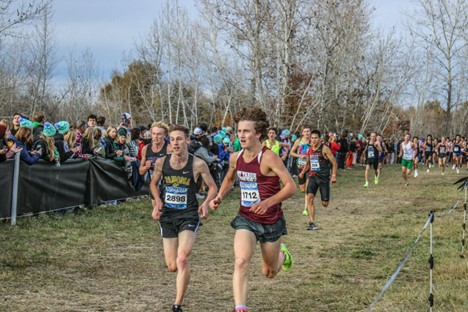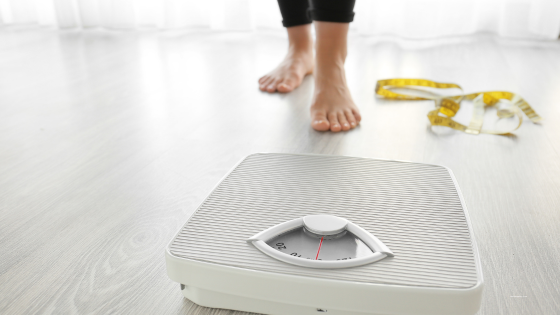 Have you ever seen how fast you can push a grocery cart? Be honest. I know each and every one of you reading this article have done it or wanted to see how fast you can get that puppy moving and jump on it at one time or another in your life.
Have you ever seen how fast you can push a grocery cart? Be honest. I know each and every one of you reading this article have done it or wanted to see how fast you can get that puppy moving and jump on it at one time or another in your life.
Let’s tie that into How Muscles Work. Which muscles would you use to get the cart going? Probably legs, to propel the cart like Fred Flintstone, pushing his car. You would need shoulder and chest strength to steady the cart and give it the final “shove”. Most importantly, you will need to use your abdominals as “stabilizers”, so that neither you nor the cart will tip over and end up in a yard sale!
God, our father, has created us with His ultimate architecture. Indeed, muscles are made for exercise AND exercise happens because of muscles. Some scholars would say that our bodies are the temple of the Holy Spirit and we should take heed to how we treat our spiritual dwelling place. Exercise continues proving major health benefits in any study we read about today.
MUSCLES NEED TO BE BROKEN DOWN TO “BUILD” THEMSELVES BACK UP
Resistance training, similar to weight training, medicine ball exercises and body weight calisthenics causes muscular disruption and possibly some muscle fiber damage. You’ve felt it. You call it, “soreness”! In athletics, when the muscle produces a force to push the weight or resistance, that muscle becomes sore (if you have trained intensely). (Ramsay, J, C. Blimkie, K. Smith, S. Garner, and J. MacDougall – 1990) The extent of this damage is less in individuals who are already working out than in first time enthusiasts. In order to “fix” the damaged muscle, a repair process of remodeling the muscle fiber may involve several of the body’s systems (e.g., hormonal, immune, and metabolic). A huge factor in the repair or “remodeling” of the muscle tissue is how the body’s systems interact with the training status of the individual and the availability of protein (Essentials of Strength Training and Conditioning – 2000).
In other words, a trainer may set up a workout program for you that is designed to address; body fat loss, or increased muscle tone. Within this program the individual sets and repetitions will be different than an athlete who desires increased muscular speed, like a lineman on a football team. The training program will be different, and the muscular response will be different. How you “remodel” the muscle tissue after you break them down will be very similar.
This information isn’t “earth shattering”, but it does provide us with some proof that we need to break ourselves down (even if only slightly) before our bodies can begin to get more tone, more defined, or become stronger.
I find it interesting that many times we have to be broken-down in order to be built up only stronger the second time around. Job, in the Bible, had this to say:
Does that mean we all have to go out and beat ourselves into the next century with our workouts? Absolutely NOT! Evaluate the following example: In the early 1900’s, many skinny, frail men, sought employment with the railroad system, due to the new era of travel. Imagine, for a moment what a “shock” it must have been to their bodies, to swing a pick, or a shovel all day long. For the first few weeks of work, they must have had muscular pain that was fairly extreme. However, over time, the muscle pain went away (while eating food and familiar, repetitive movement occurred) and an ADAPTATION took place. You may know some “blue collar” people that worked on the railroad lines, or maybe you have seen pictures of them. One thing that can always be seen is their forearms. Their forearms are huge, defined, and don’t have an ounce of fat on them. An adaptation to “training” that had to have come from the work to which they subjected their bodies.
I’m not suggesting that if you train your muscles, you are going to get huge, gnarly, forearms! Understand that you have modern training programs available to you that can address your goals; whether you are after muscle tone, muscular endurance, or building a massive muscle. The way each of us addresses our specific exercise workouts is completely different. You have to be the scientist and decide how you would like to look, feel, or live. Each desired outcome has a completely different training approach. A football player would rarely train like a marathon runner to increase their strength. Likewise, a tri-athlete would rarely train like an Ultimate Fighter in Martial Arts.
YOUR MUSCLES NEED A BREATH OF FRESH AIR
Get on a treadmill and start running and before you know it you’ll be breathing hard and your heart will start beating faster. Ever wonder why? All those muscles need oxygen. All parts of your body need energy to do their work. For example, muscles need energy to contract. Your body gets the energy it needs by combining food molecules with oxygen in a process called cellular respiration. For example, in your body, the sugar glucose is combined with oxygen to release energy your body can use. This is shown in the following chemical reaction.
C6H12O6 + 6 O2 –> 6 CO2 + 6 H2O + energy your body can use
You know that a fire needs fuel and oxygen from the air to keep burning. Similarly, your muscles and other parts of your body need to have a continuous supply of glucose (or other high-energy molecules) and oxygen to provide the energy for muscle contraction and other body functions. (Ingrid Waldron, Ph. D, University of Pennsylvania)
Although monitoring oxygen consumption can be technical for the average exerciser, we can use a different type of measurement to evaluate how we are performing. The measurement I am describing is called your Target Heart Rate. To calculate your Target Heart Rate (THR), please use the following, Karvonen’s Formula:
220 – Age – Resting Heart Rate (RHR) x .55 (55% intensity) + RHR = THR for 1 min
STRUCTURAL DESIGN OF A MUSCLE (adapted from muscle.ucsd.edu)
Skeletal muscle is a classic example of a structure-function relationship. Especially at microscopic levels, skeletal muscle is exquisitely tailored for heavy lifting and movement.
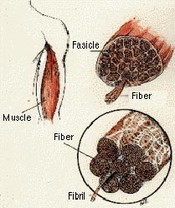 Muscle cells are roughly cylindrical, and grow up to a few centimeters long. Heavy lifting or “force production”; occurs in a unit o the muscle called the myofibrils, which are chains of small contractile units running from one end of the fiber to the other.
Muscle cells are roughly cylindrical, and grow up to a few centimeters long. Heavy lifting or “force production”; occurs in a unit o the muscle called the myofibrils, which are chains of small contractile units running from one end of the fiber to the other.
The properties of a whole muscle depend not only on the properties of the fibers, but also on the organization of those fibers: the “muscle architecture”. Peak force production is related to the physiological cross sectional area (PCSA), which estimates the sum of the cross sectional area of all the fibers. Contraction velocity are related to fiber length.
With regard to muscle strength, the body’s joints play a huge role. Joints are set up as lever systems: the fulcrum is usually where two bones meet. One force is produced by the muscle then the other force is produced by the load. The important note here is that strength is not just muscle force, but muscle force as modified by the mechanical advantage of the joint. When designing your specific program, you need to understand that joint strength can (obviously) be increased with exercise.
(adapted from muscle.ucsd.edu graphic www.muscle.ucsd.edu)
NUTRITION – AN IMPORTANT FACTOR IN MUSCULAR MOVEMENT.
The 30 MINUTE WINDOW is the most important concept in making your next workout a success. Eating nutrient dense food that is perfectly calculated for you will give you incredible advances in your fitness level, IF it is ingested during this time-frame. Research shows that the restocking of the muscles’ carbohydrate stores is two to three times as rapid immediately after exercise as it is a few hours later. In the same way, other research reveals that the repair of muscles damaged during exercise is more effective if protein is consumed immediately after exercise.
(The Paleo Diet for Athletes, 2005)
It has been said that, “Working Out is the easy part of overall health and fitness”. In truth, with so many fast food choices, which seem so convenient, AND such attractive marketing, we succumb to the enemy…Processed FOOD. There are some pretty basic truths I like to live by:
- God is good.
- God is our Father
- As our Father, He has fulfilled all our basic nutritional needs with all He has provided on this earth
In a nutshell, we need to take a very strong look at our intake and assure ourselves that it contains:
- Raw, uncooked Vegetables
- Raw, uncooked fruit
- Raw, unbleached, uncooked nuts and seeds
- Clean protein sources from naturally occurring sources
Steve Born, from the Hammer Nutrition adds, “Once you’ve finished training, you’re still not finished with training! How well you recover today will be a huge factor in how well you perform tomorrow. Exercise creates physiological stress; you become weak and depleted after a good workout. It is during recovery that your body rebuilds itself. Your body responds to the stress of training by increasing its stress adaptation, commonly called “fitness,” but only when you have all recovery components in place. Repeated, incremental sessions of exercise and properly supported recovery result in increased performance ability and improved overall health. Exercise that is either overdone or under supported by a lack of proper recovery yields negative results, such as injury, chronic fatigue, soreness, overuse syndrome, poor health, and the like. You must attend as much to recovery as you do to active exercise if you expect to reap the benefits of hard training. (Steve Born, www.hammernutrition.com)
Power Cleans
- It doesn’t matter if you are 5 years old or 105 years old.
- It doesn’t matter if you are interested in a lean, defined physique or a massive bodybuilder physique.
- Any program developed without some form of a clean is inadequate.
- Power cleans can be performed with a soup can, a broomstick, a medicine ball, a weighted Olympic bar, or dumbbells.
Proper technique begins with the beginning stance. The feet are shoulder width apart with the knees inside the arms. The back retains a “flat” posture with flexion of the knees and hips that result in the knees in front of the bar. In this position, the heels are flat, arms fully extended, shoulders are over or slightly ahead of the bar. A flat back posture is attained by retracting the shoulder blades, holding the chest up and out, and tilting the head slightly up (DO NOT LOOK UP).
Upward Movement Phase: First pull
Begin this motion by extending the knees, moving the hips forward and raising the shoulders. The angle of the back is kept constant. The bar then begins to be lifted up. The bar is kept close to the body, retaining straight elbows while keeping the heels on the floor.
Upward Movement Phase: Scoop
This motion begins with a hip thrust forward while continuing to pull upward with legs extending the knees. The torso should be nearly vertical and erect. The shoulders are still positioned directly over the bar with the elbows fully extended.
Upward Movement Phase: Second Pull
This is the explosive portion of the lift. The lifter continues to maintain a flat back while keeping the bar close to the body. Move the bar up by explosively extending the hip, knee, and ankle joints in a jumping action. Do not actually allow the feet to leave the ground, the toes should remain in contact with the ground. At the body’s highest point, shrug the shoulders, flex and pull with the arms. The elbows are kept high during the pull while keeping them over the wrists.
Catch Phase
During the catch phase the lifter rotates their elbows around and under the bar. The wrists extend as the elbows move under the bar. The elbows should point forward or slightly up while the bar is “racked” across the front of the shoulders. The back is kept erect while the hips and knees flex to absorb the weight of the bar. The athlete then straightens the hips and knees completing the lift.
Downward Movement Phase
The bar is slowly lowered and under control to the top of the thighs. The hips and knees then flex as the bar lands on the thighs. Squat down toward the floor maintaining an erect spine and heels on the floor. The bar is then lowered, close to the shins, and placed on the floor. The body should be in the same position as at the beginning of the lift.
As described, the Power Clean and Hang Clean are excellent weight training exercises to develop core and explosive muscle strength. Proper technique must be stressed for the beginning lifters versus weight.
Concept II or Open Water Rowing
- Quite possibly the best full body movement available to complete indoors. A close second is the Versa-climber and the Nordic Trac.
- This full body workout will need to be started VERY slow and methodical and gradually built up in time and resistance.
- Delivering oxygen to the working muscles is critical to muscular efficiency and development of their ability to sustain elevated work loads.
PROPER ROWING TECHNIQUE
The Catch
- Extend arms straight toward the flywheel.
- Keep wrists flat.
- Lean your upper body slightly forward with back straight but not stiff.
- Slide forward on the seat until your shins are vertical (or as close to this as your flexibility will allow).
The Drive
- Begin the drive by pressing down your legs.
- Keep your arms straight and hold your back firm to transfer your leg power up to the handle.
- Gradually bend your arms and swing back with your upper body, prying against the legs until you reach a slight backward lean at the finish.
The Finish
- Pull handle all the way into your abdomen.
- Straighten your legs.
- Lean your upper body back slightly.
The Recovery
- Extend your arms toward the flywheel.
- Lean your upper body forward at the hips to follow the arms.
- Gradually bend legs to slide forward on the seat.
The Catch
- Draw your body forward until the shins are vertical.
- Upper body should be leaning forward at the hips.
- Arms should be fully extended.
- You are ready to take the next stroke.
Pull-ups (sometimes called a “chin-up”)
Not only the hardest exercise known to man, but also the most feared!
The functionality and ability to pull oneself up with their own bodyweight to a “chinned” position, is a goal everyone should shoot for.
If you have never attempted a pull-up or a chin, complete a “hold”, with your chin above the bar prior to trying a pull-up. Once you can “hold” yourself above the chinning bar for 10 seconds, you will be ready to attempt a pull-up.
If you are past the “holding stage”, try an assisted pull-up, with a chair. Use your legs to assist you in your attempt, but only use 50% of your leg strength to complete 1 repetition. Really try and pressure your arms into doing the work.
Grip the pull-up bar with your hands about 6 to 8 inches wider than shoulder width. Start with your body hanging and your arms straight giving your back a complete stretch.
With force, pull yourself up until your chin is over the bar and your back is contracted.
Lower yourself under control until you are back to the original starting position. Hold the stretch for about a second and then repeat the motion.
Swimming
This exercise speaks for itself.
Full body movement, consistent breathing
Most people are uncomfortable in the water. Challenge yourself to do something your body may not be accustomed to. Think of your favorite Bible character that was challenged to complete a task they thought they were “unfit” to do.
Overhead Squats
Start with a wooden dowel.
As you become comfortable with the movement, move to a heavier weight. Eventually, an Olympic bar can be used. Who knows, you may even add weight to the Olympic bar!
Stand over the barbell with the balls of the feet positioned under the bar hip width or slightly wider than hip width apart. Squat down and grip the bar with an very wide over hand grip. Position the shoulders over the bar with the back arched tightly. Arms are straight with elbows pointed along the bar.
Pull the bar up off the floor by extending the hips and knees. As the bar reaches the knees the back stays arched and maintains the same angle to the floor as in the starting position. When the barbell passes the knees vigorously raise the shoulders while keeping the bar as close to the legs as possible. When the bar passes the upper thighs allow it to contact the thighs. Jump upward extending the body. Shrug the shoulders and pull the barbell upward with the arms allowing the elbows to pull up to the sides, keeping them over the bar as long as possible. Aggressively pulls the body under the bar. Catch the bar at arms length while moving into the squat position. As soon as the barbell caught on the locked out arms in the squat position, squat up into standing position with barbell overhead.
Maintain bar behind head with arms extended. Descend until knees and hips are fully bent or until thighs are just past parallel to floor. Knees travel in direction of toes. Extend knees and hips until legs are straight. Return and repeat.
Keep head forward, back straight and feet flat on the floor; equal distribution of weight through forefoot and heel.
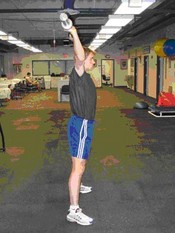
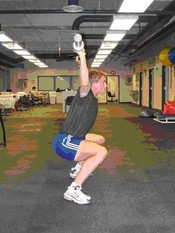
Before starting any exercise program, or if you have been sedentary for more than 30 days, Faith and Fitness Magazine, recommends each reader consult their physician prior to exercise.



